This blog will be going over my Solar Oven Design project for one of my projects done for the Academy of Engineering at Southern Lee High School, date being May 11, 2023
Solar Oven Design: Harnessing Sunlight to Heat Water
During my fourth year in my high school engineering program, I took on the challenge of designing a solar oven that could efficiently heat water using only sunlight. The goal was to create something functional, cost-effective, and easy to assemble while also improving my skills in modeling and design. I wanted to see if I could make a solar cooker using mostly recycled or low-cost materials without sacrificing performance.
The Inspiration Behind the Project
Solar energy has long been recognized as a sustainable alternative to traditional heating methods, yet many existing solar cookers and ovens are either too expensive or not durable enough for widespread use. My goal was to develop a model that could be built with recycled or low-cost materials while still providing effective heating capabilities. This approach aligned with my passion for making technology more accessible and affordable for communities that could benefit from renewable energy solutions.
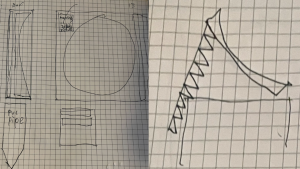
Design and Material Selection
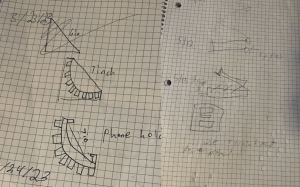
At the heart of this project was the idea of harnessing a parabolic reflector to concentrate sunlight onto a focal point where a water container would be placed.
First, I will be drafting my ideas and concepts into my Design notebook with further details on the way the solar oven will operate to heat water. Using SolidWorks, I designed the parabolic shape to ensure optimal heat concentration, making sure that adjustments could be made to maximize exposure to the sun throughout the day.
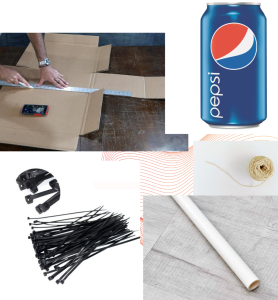
Material selection was another key factor in the design process. I opted for cardboard, PVC pipes, zip ties, and a recycled tin can to keep costs low. Initially, the decision to use lightweight materials seemed like a practical choice—it allowed for easy transport and assembly. However, testing revealed that this came at the cost of durability, leading to design iterations to improve structural integrity.
Engineering the Design
Using SolidWorks, I modeled a parabolic reflector to focus sunlight onto a small point, ensuring efficient heat concentration. The design had to balance performance, durability, and affordability, so I used recycled materials—cardboard for the frame, PVC pipes and zip ties for support, and a tin can as the water container. The biggest challenge was maintaining structural integrity while keeping the cost under $25, with the reflective surface being the most expensive component.
From the start, design played a huge role in this project. My goal was to create a solar oven that could be mass-produced and shipped at a low cost while still being effective for boiling water.
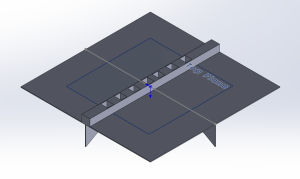
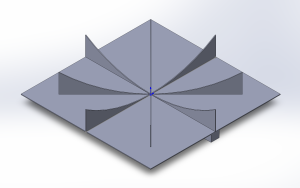
I spent a lot of time in SolidWorks, experimenting with different shapes, materials, and structures to find the best design. The parabolic reflector was the key to concentrating sunlight, so I modeled and refined its shape to make sure it directed heat properly. I went through several design iterations, adjusting the size, angle, and support system before settling on a version that seemed the most efficient.
While the SolidWorks models looked promising, real-world testing revealed challenges I hadn’t expected. My first prototype, which I built based on the CAD model, collapsed under light wind conditions. This was an important lesson—just because something works in CAD doesn’t mean it will work in real life. To fix this, I went back into SolidWorks and reworked the structure, reinforcing the base and the support system to make it more stable.
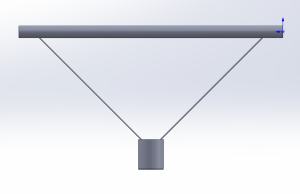
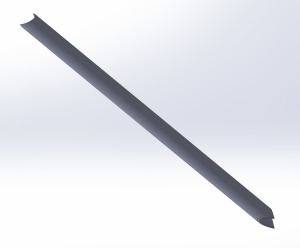 As I continued testing, I kept refining the design in SolidWorks, making small but important changes. I adjusted the parabola’s focal point to improve heat concentration, ensuring that sunlight would hit the tin can at the right angle for maximum efficiency. I also worked on making the stand adjustable, so the oven could be tilted throughout the day to track the sun. Since keeping the design low-cost was a priority, I had to balance stability with affordability, testing different materials in both CAD simulations and physical prototypes. This project reinforced my understanding of engineering design, prototyping, and iterative problem-solving. SolidWorks wasn’t just a tool for sketching ideas—it became an essential part of my testing and improvement process. By continuously refining my models, I was able to predict weak points, optimize efficiency, and reduce costs before physically building anything. In the end, this project wasn’t just about designing a solar oven; it was about learning how to turn an idea into a real, functional product through careful design, testing, and iteration.
As I continued testing, I kept refining the design in SolidWorks, making small but important changes. I adjusted the parabola’s focal point to improve heat concentration, ensuring that sunlight would hit the tin can at the right angle for maximum efficiency. I also worked on making the stand adjustable, so the oven could be tilted throughout the day to track the sun. Since keeping the design low-cost was a priority, I had to balance stability with affordability, testing different materials in both CAD simulations and physical prototypes. This project reinforced my understanding of engineering design, prototyping, and iterative problem-solving. SolidWorks wasn’t just a tool for sketching ideas—it became an essential part of my testing and improvement process. By continuously refining my models, I was able to predict weak points, optimize efficiency, and reduce costs before physically building anything. In the end, this project wasn’t just about designing a solar oven; it was about learning how to turn an idea into a real, functional product through careful design, testing, and iteration.
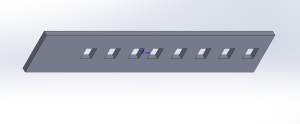
Testing Process Overview
To test the solar oven’s effectiveness, we focused on two main factors: structural stability and heating efficiency. First, we set up the oven outdoors and observed how well it held up against different wind conditions. The initial prototype collapsed almost immediately in a 5 mph wind with gusts up to 15 mph, so we reinforced the structure and tested again. The second version lasted 17 minutes before collapsing under wind speeds of 17-20 mph with gusts reaching 25 mph. This showed us that stability needed major improvements, especially for real-world outdoor use.
For heating efficiency, we placed 8 oz of water in a tin can, positioned the oven toward the sun, and recorded the temperature every minute for 15 minutes using a heat reader. We started at 64°F, and over time, the water temperature increased steadily, reaching 105°F by the end of the test. The heating rate averaged 2.7°F per minute, but we noticed that the rate slowed as the water got hotter. These tests helped us identify where the design worked well and where adjustments—like improving reflectivity, optimizing the sun angle, and reducing heat loss could make a difference.
Building the prototype for this testing
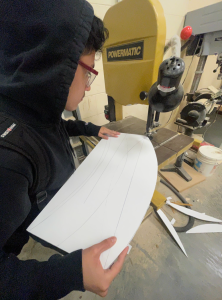
Prototyping played a critical role in developing the solar oven, as each test provided valuable insights that helped refine the design. The initial prototype failed almost immediately, collapsing under a light 5 mph wind with gusts reaching 15 mph. This exposed a major flaw—the structure wasn’t stable enough to handle outdoor conditions, making it clear that reinforcements were necessary.
For the second prototype, we strengthened the frame, hoping to improve stability. While it lasted longer, it still collapsed after 17 minutes when exposed to wind speeds ranging from 17 mph to 20 mph, with gusts reaching 25 mph. This confirmed that while the design improvements helped, they weren’t enough for real-world conditions. During further testing, stronger gusts between 28-32 mph caused the structure to completely fail, proving that additional structural reinforcements were required.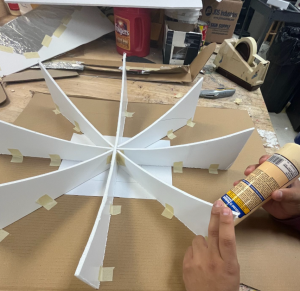
Beyond stability, we also focused on testing the heat absorption and efficiency of the oven. Using a heat reader and timed data collection, we tracked how well the solar oven heated water over 15 minutes. We started with an initial water temperature of 64°F, and by the end of the test, it reached 105°F, averaging a heating rate of 2.7°F per minute. However, as expected, the rate slowed over time as heat loss became a factor.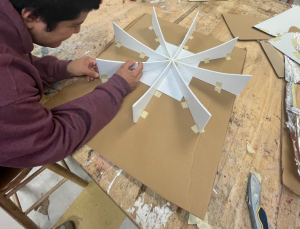
These prototyping and testing cycles allowed us to evaluate both structural performance and thermal efficiency. Each failure helped guide design improvements, ensuring that the oven wasn’t just functional in ideal conditions but could also withstand real-world environmental factors. Our next steps focused on reinforcing the support system further while keeping the overall cost low, demonstrating the importance of iterative design, real-world testing, and continuous improvement in engineering solutions.
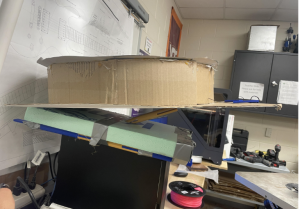
Revision and Design Fixes
The biggest issue with the solar oven was its lack of stability in outdoor conditions. The prototype collapsed under 5 mph winds, and the second version, even after reinforcements, only lasted 17 minutes before failing in gusts up to 25 mph. The frame was too weak, and the support system wasn’t secure enough to handle real-world use. To fix this, the materials needed to be stronger but still lightweight and affordable. Thin sheet metal or reinforced plastic would replace the cardboard frame, providing better durability. The base also required a stronger anchoring system, such as weighted legs or ground stakes, to keep the oven stable even in rougher conditions. Widening the stance of the support legs would further prevent tipping and ensure the structure held up over time.
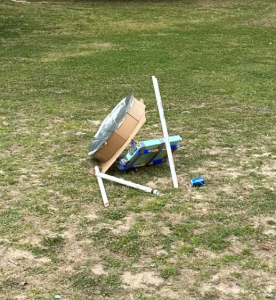
The second issue was heat efficiency. While the water temperature increased from 64°F to 105°F in 15 minutes, heat was escaping too quickly. A better reflective surface, an insulated tin can, and a clear plastic or glass cover would help trap and retain heat more effectively.
Further on, the design needed to be more practical. A collapsible or modular build with hinged reflectors and detachable components would make it easier to store, ship, and set up while keeping costs low. Testing proved that real-world adjustments are just as important as the initial design. The SolidWorks model looked good, but hands-on testing revealed key flaws that required revisions. The biggest takeaway was that engineering is about problem-solving and iteration. If done again, the focus would be on structure and small-scale testing first before full trials. This project reinforced that constant refining is key to turning a concept into a successful product.
